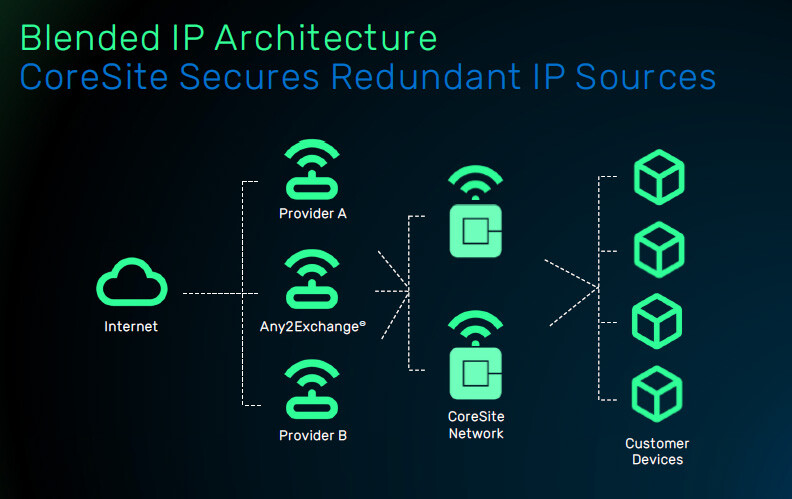
Stellar Internet Service with a Slightly Wonky Name: Blended IP
Every company has an internal jargon, a type of tribal knowledge that can be confusing. When I joined CoreSite, the term “BIP” (short for Blended IP) threw me for a loop. It was especially troubling because as Product Management Director, I am on the team responsible for bringing BIP to market. If I couldn’t understand what BIP meant, how can you?
So … let me explain, because every enterprise needs BIP.
Check out this video to learn how Blended IP can help you achieve highly reliable, cost-effective, stable and consistent connectivity, everywhere you do business.
Names Don’t Matter; Performance, Reliability and Value Do
Blended IP is CoreSite’s product for connecting to the internet via Tier 1 carriers through our data centers. It was initially developed to enable an “out of band” internet connection, one that is completely isolated from the production internet connection. It has since evolved into a solution that is ideal for production environments. With Blended IP, even if the primary connection goes down, technicians and engineers can still access the equipment without having to be physically present. It is the “back door” into production environments when all else has failed.
That's important because 100% uptime has become an existential business requirement for almost all enterprises. A moment ago, I mentioned that Blended IP is a solution for connecting to the internet through Tier 1 networks. Blended IP also enables our customers to failover to other carrier networks interconnected in our “carrier neutral” colocation facilities, if need be.
Here’s how that works. In the rare circumstance that the primary, redundant network architecture – which connects to two or more networks – fails, the intelligent, automated routing protocol designed into the solution will direct traffic to the most logical data center, where it is then handed off to a network peer. Ultimately, the data (voice, video, AI-generated, etc.) goes from its source to the intended destination, but over yet another Tier 1 provider that is connected to CoreSite.
When you include Blended IP in your deployment, you not only have access to multiple upstream internet service providers (ISPs) and direct peering between carriers, you can access local internet exchanges. Much like a data center, an internet exchange is a place where multiple ISPs and network operators interconnect their networks.
Customers with Blended IP can take advantage of another CoreSite product: the Any2Exchange®. With 400+ members, Any2Exchange is the second largest internet exchange in the United States and the largest internet exchange on the West Coast. So, for example, if you are a customer in Denver and need to interact with another platform in Denver, we don’t have to send data out and back through to the public internet. We can loop it though through our Any2Exchange connection, rather than over a commercial circuit, which saves you money and assures low latency transport. As we say here, Any2Exchange “keeps local traffic local.”
Other Blended IP advantages include:
- The flexibility to opt for 10MB – 10GB speeds
- Enterprise-class internet with optimized performance to leading SaaS and content providers
- Better redundancy, bandwidth and improved latency
- Expanded bandwidth management and public cloud connectivity
- Different options for connectivity, bandwidth and routing
- 100% uptime SLA in all markets
- 72-hour activation
- One combined bill for internet and your data center solutions
Two more big pluses: Blended IP is rolled into your data center lease as a fixed service rate, so it’s easier to manage your budget. Second, you don’t need to design, deploy and manage complex BGP networks and multiple providers.

Blended IP combines upstream internet service providers (ISPs) and local internet exchanges (including the Any2Exchange) to get you fast, redundant data transfer.
Simplifying Complexity While Establishing Redundancy
Which leads me to what I have learned lately when talking with customers about their challenges. First, because their infrastructure has grown to be so complex, it is difficult to manage. Second is the absolute need for redundancy.
Blended IP solves both of those challenges. Instead of the customer having to hire a special Border Gateway Protocol (BGP) engineer to design, implement and manage interconnections, CoreSite handles it. Also, as I’ve described, redundancy is built-in to Blended IP and bolstered by the CoreSite intra-site and intra-market approach to data center interconnection, which ensures uptime and is the foundation for our 100% uptime SLA. That approach is a significant differentiator, by the way. Decades of providing 400+ networks with a hub for interconnection is a difficult to match.
As Shakespeare Said: “What’s in a Name?”
Now you know. When we say Blended IP, you know it’s CoreSite jargon for “internet access essential to an enterprise.”
I’ll admit, I don’t think Blended IP is the most descriptive product name in the industry. I do believe, however, that it’s a service every one of our customers should consider.
Please feel free to contact me directly via email or phone (720-603-8293) or get in touch with a CoreSite sales representative to take the next step to enterprise-class, fully optimized internet service.
Know More
The next best step in learning more about CoreSite interconnection products including Blended IP, the Any2Exchange, the Open Cloud Exchange® and hundreds of network providers available though CoreSite's 30 data centers in 11 regions around the U.S? Click here!











